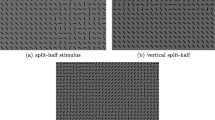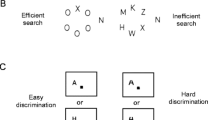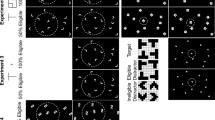Summary
In research on visual search within a single eye fixation, a number of different tasks are used and referred to interchangeably. In a previous study, we showed that there are differences between “go- no go” tasks and “yes-no” tasks, and we introduced a tentative model in order to explain these differences. In the present study a “go- no go” task and a “detection” task are compared under conditions which are as equal as possible. Traditional views of the visual search process predict no essential differences between the two tasks. The tentative model predicts a steeper slope of the array-size function in the “detection” task than in the “go- no go” task and predicts that this difference in slopes is stable with practice. The results obtained appeared in accordance with the predictions of the tentative model. This result supports the point of view that response-related factors strongly contribute to the slope of the array-size function. The data are not in accord with predictions following from Estes' (1972) interactive channels model.
Similar content being viewed by others
References
Allport DA (1980) Attention and performance. In: Claxton G (ed) Cognitive psychology, new directions. Routledge & Kegan Paul, London
Atkinson RC, Holmgren JE, Juola JF (1969) Processing time as influenced by the number of elements in a visual display. Percept Psychophys 6:321–326
Averbach E, Coriell AS (1961) Short-term memory in vision. Bell Syst Tech J 40:309–328
Bjork EL, Murray JT (1977) On the nature of input channels in visual processing. Psychol Rev 84:472–484
Donders FC (1969) On the speed of mental processes. In: Koster WG (ed and trans) Attention and performance II. North Holland, Amsterdam (Originally published 1868)
Egeth H, Atkinson J, Gilmore G, Marcus N (1973) Factors affecting processing mode in visual search. Percept Psychophys 13:394–402
Egeth H, Jonides J, Wall S (1972) Parallel processing of multielement displays. Cogn Psychol 3:674–698
Estes WK (1972) Interactions of signal and background variables in visual processing. Percept Psychophys 12:278–286
Estes WK (1978) Perceptual processing in letter recognition and reading. In: Carterette EC, Friedman MP (eds) Handbook of perception, Vol IX. Academic Press, New York
Estes WK, Taylor HA (1964) A detection method and probabilistic models for assessing information processing from brief visual displays. Proceedings of the National Academy of Science 52:446–454
Estes WK, Taylor HA (1966) Visual detection in relation to display size and redundancy of critical elements. Percept Psychophys 1:9–16
Gilmore GC, Hersh A, Caramazza A, Griffin J (1979) Multidimensional letter similarity derived from recognition errors. Percept Psychophys 25:425–431
Gleitman H, Jonides J (1976) The cost of categorization in visual search: incomplete processing of target and field items. Percept Psychophys 20:281–288
Holmgren JE (1974) Visual search in a forced-choice paradigm. Percept Psychophys 16:253–258
Keren G, Baggen S (1981) Recognition models of alphanumeric characters. Percept Psychophys 29:234–246
La Heij W, Van der Heijden AHC (1983) Feature-specific interference in letter identification. Acta Psychol 53:37–60
Logan GD (1978) Attention in character-classification tasks: evidence for the automaticity of component stages. J Exp Psychol Gen 107:32–63
Nickerson RS (1972) Binary classification reaction time: a review of some studies of human information-processing capabilities. Psychon Monogr Suppl 4, 17 (whole no 65)
Norman DA (1968) Towards a theory of memory and attention. Psychol Rev 75:522–536
Ogden GD, Alluisi EA (1980) Stimulus-response compatibility effects in choice reactions and memory scanning. J Exp Psychol Hum Learn Mem 6:430–438
Schneider W, Shiffrin RM (1977) Controlled and automatic human information processing: I. Detection, search and attention. Psychol Rev 84:1–66
Sperling G (1960) The information available in brief visual presentations. Psychol Monogr 74 (no 11)
Sternberg S (1966) High-speed scanning in human memory. Science 153:652–654
Townsend JT (1971a) Theoretical analysis of an alphabetic confusion matrix. Percept Psychophys 9:40–50
Townsend JT (1974) Issues and models concerning the processing of a finite number of inputs. In: Kantowitz BH (ed) Human Information processing: Tutorials in performance and cognition. Erlbaum, Hillsdale, NJ
Van der Heijden AHC (1981) Short-term visual information forgetting. Routledge & Kegan Paul, The International Library of Psychology, London
Van der Heijden AHC, La Heij W (1982) The array size function in simple visual search tasks: A comparison between “go- no go” and “yes-no” tasks under conditions of high and low target-noise similarity. Psychol Res 44:355–368
Author information
Authors and Affiliations
Rights and permissions
About this article
Cite this article
van der Heijden, A.H.C., La Heij, W. The array-size function in simple visual search tasks: A comparison between a “go- no go” and a “detection” task under conditions of low target-noise similarity. Psychol. Res 45, 221–234 (1983). https://doi.org/10.1007/BF00308703
Received:
Issue Date:
DOI: https://doi.org/10.1007/BF00308703




